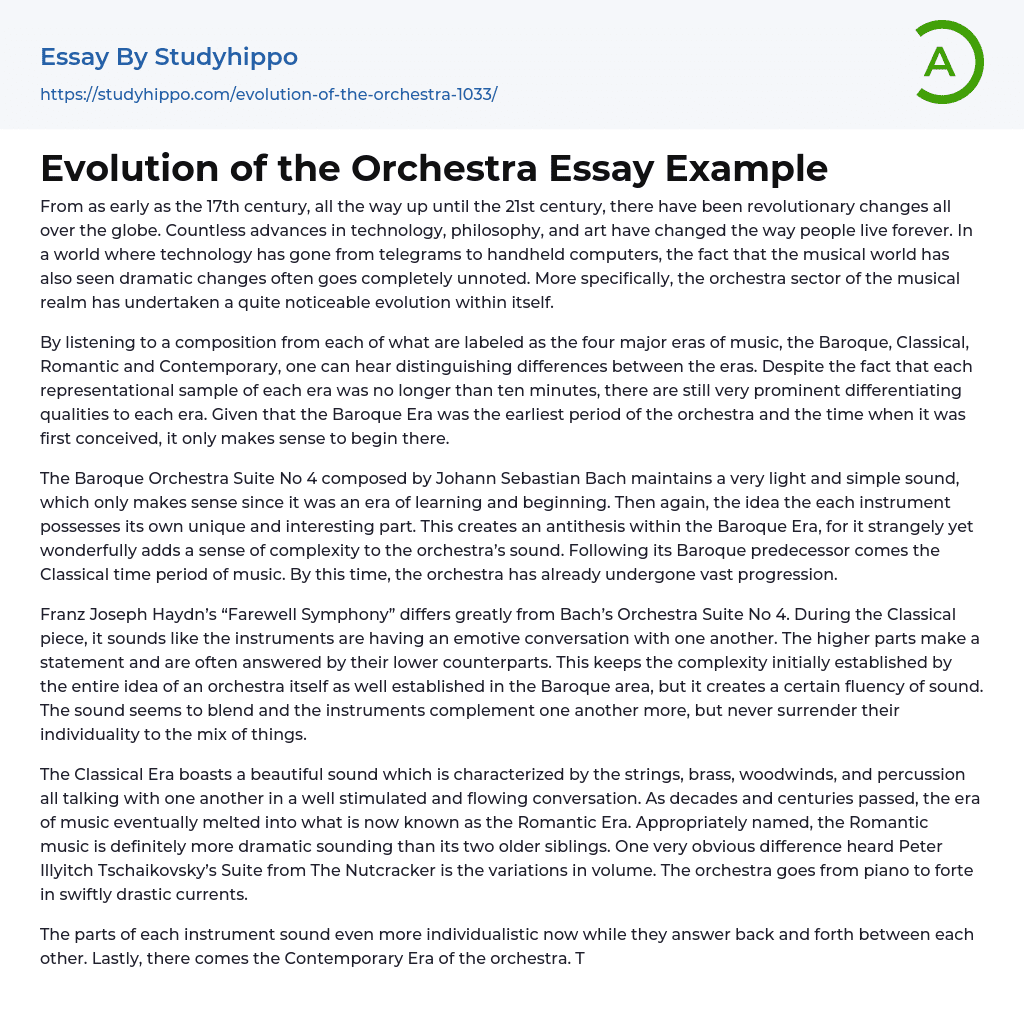From as early as the 17th century, all the way up until the 21st century, there have been revolutionary changes all over the globe. Countless advances in technology, philosophy, and art have changed the way people live forever. In a world where technology has gone from telegrams to handheld computers, the fact that the musical world has also seen dramatic changes often goes completely unnoted. More specifically, the orchestra sector of the musical realm has undertaken a quite noticeable evolution within itself.
By listening to a composition from each of what are labeled as the four major eras of music, the Baroque, Classical, Romantic and Contemporary, one can hear distinguishing differences between the eras. Despite the fact that each representational sample of each era was no longer than ten minutes, there are still very prominent differentiating qualities t
...o each era. Given that the Baroque Era was the earliest period of the orchestra and the time when it was first conceived, it only makes sense to begin there.
The Baroque Orchestra Suite No 4 composed by Johann Sebastian Bach maintains a very light and simple sound, which only makes sense since it was an era of learning and beginning. Then again, the idea the each instrument possesses its own unique and interesting part. This creates an antithesis within the Baroque Era, for it strangely yet wonderfully adds a sense of complexity to the orchestra’s sound. Following its Baroque predecessor comes the Classical time period of music. By this time, the orchestra has already undergone vast progression.
Franz Joseph Haydn’s “Farewell Symphony” differs greatly from Bach’s Orchestra Suite No 4. During the Classical piece, it sounds like the instruments ar
having an emotive conversation with one another. The higher parts make a statement and are often answered by their lower counterparts. This keeps the complexity initially established by the entire idea of an orchestra itself as well established in the Baroque area, but it creates a certain fluency of sound. The sound seems to blend and the instruments complement one another more, but never surrender their individuality to the mix of things.
The Classical Era boasts a beautiful sound which is characterized by the strings, brass, woodwinds, and percussion all talking with one another in a well stimulated and flowing conversation. As decades and centuries passed, the era of music eventually melted into what is now known as the Romantic Era. Appropriately named, the Romantic music is definitely more dramatic sounding than its two older siblings. One very obvious difference heard Peter Illyitch Tschaikovsky’s Suite from The Nutcracker is the variations in volume. The orchestra goes from piano to forte in swiftly drastic currents.
The parts of each instrument sound even more individualistic now while they answer back and forth between each other. Lastly, there comes the Contemporary Era of the orchestra. Today’s music seems almost completely alien to its birthplace in the Baroque times. By now, the harpsichord is all but completely forgotten and the music is much more experimental. One might expect to hear Bach’s or Haydn’s masterpieces at a tea party or ball, but having Aaron Copland’s Suite from Billy The Kid playing might come off as a bit absurd.
While the earliest two eras express what seems mostly like raw and deep emotions, the latter two eras tell more of a story. It’s true
that many orchestras and pieces are written to be used as music for movies and plays. After all, motion pictures would have little impact if it weren’t for the music that establishes the mood and atmosphere. The instruments don’t seem quite as communicative with each other as before, but they do seem to feature many solos. Of course, the orchestra does maintain a flow that appeals to the listener.
The Contemporary music offers the most variety out of the four. Ultimately, it is definitely safe to say that none of the eras of music inferior to one another. Although vastly different, the Baroque, Classical, Romantic, and Contemporary time periods all hold immeasurable value in their unique ability to entertain and intrigue the audience’s ear. Time goes hand in hand with change and evolution, and the changes seen in the orchestra are a living and still developing example of that.
The orchestra starts off as simple, very unified and whole, but eventually spills into a composition of conversations and solos between the unique instruments. Volume tends to become an increasingly important role as time marches on. Nearly every aspect of orchestras has evolved and changed whether it is the general feel of the music to the actual instruments being played. In the end, every composer manages to write orchestral music that maintains a fluency that creates a certain beauty that might have never been achieved by an instrument all by itself of a number of instruments all playing the same part.
- Band essays
- Baroque Music essays
- Blues essays
- Classical Concert essays
- Classical Music essays
- Concert essays
- Hip Hop essays
- Jazz essays
- Ludwig Van Beethoven essays
- Michael Jackson essays
- Mp3 essays
- Music Concert Report essays
- Music Reference essays
- Music video essays
- Musical Instruments essays
- Opera essays
- Piano essays
- Popular music essays
- Recording essays
- Rock And Roll essays
- Rock Music essays
- Singing essays
- Sonata essays
- Song essays
- Sonnet essays
- Tupac shakur essays




